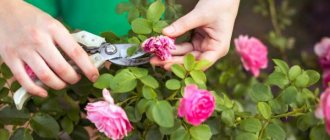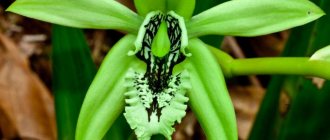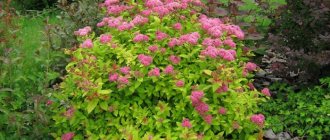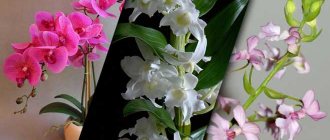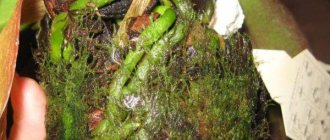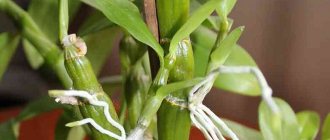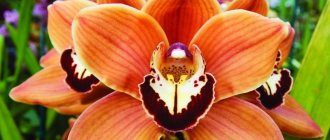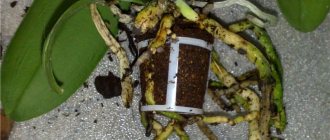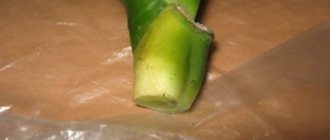Types of coelogina
In the culture of European floriculture, out of more than a hundred species, several of them have been cultivated, which are most suitable for growing at home. Coelogyne cristata (lat. Coelogyne cristata). It has two evergreen leaves at the base of the bulb and large flowers, reaching up to 10 cm in diameter, collected in a raceme inflorescence.
Drooping coelogyne (lat. Coelogyne flaccida). The plant is characterized by cream-sand-colored inflorescences with medium-sized flowers, up to 5 cm in diameter.
Coelogyne massangeana (lat. Coelogyne massangeana). This species has the longest inflorescence, pale yellow in color with a characteristic sweetish odor and small flowers.
Coelogina splendor
Growth:
From Nepal through Sikkim and Bhutan to the Khasi Mountains in northeast India, upper Burma, Yunnan Province in southwest China, Thailand and Laos. The plants are found at altitudes of 1500–2300 m. They grow on moss-covered trees and rocks in regions where fog and drizzle form throughout most of the year. Plants found in the subtropical zone at lower altitudes usually grow on trees in mixed forests and areas covered with dwarf vegetation in regions with cold, sunny and dry winters.
Climate in natural habitats:
- Fixed temperature range from –3°C to +25°C.
- The average humidity all year round is 80%.
- Precipitation from 13 mm. in January up to 798 mm. in June.
- Average temperatures (day/night) from +8.3°C/+1.7°C in January to +18.9°C/+14.4°C in May.
Description of the plant:
Plant size and type:
Epiphyte with a sympodial growth type, height 22–30 cm.
Pseudobulbs:
Pseudobulbs are 7.5–10.0 cm long. They are oval-cylindrical and wrinkle over time. The growths are located on thick rhizomes at a distance of 2.0–2.5 cm from each other.
Leaves:
A pair of elliptical or lanceolate pointed leaves, 15–20 cm long and about 2.5 cm wide, grows at the top of each pseudobulb.
Peduncle:
An erect or pendulous peduncle, about 20 cm long, grows from the middle of the new growth even before the leaves open and the pseudobulb forms.
Flowers:
The peduncle bears from 3 to 8 beautiful fragrant flowers with a diameter of about 4 cm, located in the upper part of the flower shoot. The flowers are white, with eye-like orange-yellow spots on the lateral parts of the lip. The open, pointed petals and sepals are similar in shape and size, but the sepals are usually slightly longer and wider than the petals.
Flowering period: from March to June.
Agricultural technology:
Temperature:
The plant requires moderate to cool temperature conditions. In summer, the average daytime temperature is +18–23°C, nighttime +13–14°C with a daily difference of about 5°C. The plant can be adapted to warmer conditions in the afternoon as long as there is high humidity, strong ventilation and cooler temperatures in the evening.
Lighting:
15000–25000 lux. Constant ventilation is required. During the summer monsoon season, the sky in the places where Celogina brilliantis grows is often covered with clouds, so from spring to late autumn the plant needs to be shaded. The light must be filtered or diffused. The orchid must be protected from direct sunlight, especially at noon. In nature, the highest illumination occurs during the dry winter period, when the sky is clear most of the time.
Watering:
From late spring to autumn precipitation is very heavy, but in autumn it stops abruptly and a 3-5 month dry period begins. In cultivation, during the period of intensive growth, plants need to be well watered, but the substrate should not be allowed to become wet or decompose. When new growths mature in the fall, reduce the amount of water.
Fertilizer:
During the period of active growth, plants are fed weekly with 1/4–1/2 the recommended dose of fertilizer for orchids. Most orchid lovers use fertilizer containing nitrogen, potassium and phosphorus in equal proportions throughout the growing season. But many orchid gardeners advise using a fertilizer with less nitrogen and more phosphorus in the fall to improve flowering next season and strengthen new growth before winter.
In order to avoid the accumulation of mineral salts during intensive feeding, it is recommended to rinse the substrate approximately once a month, which is especially important in regions with hard water. To do this, first water the plant, after which about an hour later, when the salts have dissolved, the substrate is washed with water in an amount equal to twice the volume of the pot.
Substrate:
Coelogina splendor grows well on pieces of tree fern or cork, but in hot and clear summer weather the plant requires high humidity and repeated watering throughout the day. Most orchid gardeners prefer to plant this species in pots or baskets. The best results are obtained when grown in baskets lined with sphagnum moss. Since plants require abundant watering, the substrate must be breathable and loose, but at the same time must retain a significant portion of moisture. A well-proven substrate consisting of chopped tree fern fibers mixed with 10% perlite, 10% chopped sphagnum and 10% charcoal. This substrate decomposes very slowly. You can also use pine bark, adding components that retain moisture, but in this case the plant will have to be replanted more often, since the bark decomposes faster.
Most species of the genus Celogina should be replanted only when absolutely necessary. The shock caused by replanting can inhibit the flowering of an orchid for up to three years. Some orchidists advise removing old bulbs instead of replanting. But if replanting is still necessary, it should be carried out at the moment of growth of new roots, as a rule, immediately after flowering.
Air humidity:
85–95% most of the year, but drops to 75–80% from late fall to spring.
Rest period:
In winter, the average daytime temperature in nature is +8–9°C, nighttime +2–3°C with a daily difference of 7°C. During the three months of late autumn and early winter there is little rain, but additional moisture is provided by frequent fogs, dew and drizzle. Therefore, in culture, watering in winter should be limited, but the plants should not be allowed to remain dry for a long time. In most cases, light watering every three weeks and occasional misting will be sufficient.
A cold and dry dormant period is necessary for Coelogina splendor for healthy growth and good flowering, but it should not be as long and harsh as in nature.
Low temperatures (around 9-10°C) along with limited watering for about three months will ensure this dormancy. Editorial team LePlants.ru
Botanical description
Coelogyne (lat. Coelogyne), belongs to the Orchid family (lat. Orchidaceae) and is an epiphytic or terrestrial flowering perennial plant.
On one rhizome the stems are densely or more loosely arranged. They can have a glossy or matte surface. Their shape can be oval, cylindrical or disc-shaped with a ribbed or smooth structure.
On the stems there are linear leaves located in pairs or singly, which are narrowed towards the base. Peduncles emerge from the tops of the stems or their bases. Multi-flowered inflorescences are drooping.
Lighting and temperature
Coelogina is a light-loving plant. If you place it in the northern part of the house, then flowering will most likely become a rare occurrence for this orchid. There should be a lot of light, bright and diffused.
Direct sunlight, especially on a hot day, can seriously damage the leaves and inflorescences of the plant. Therefore, on hot days of summer, it is advisable to shade the plant.
Temperature has less of an impact on flower development, but still. The average value for comfortable growth of cellulina should be +22+24°C. Cooler conditions will also suit the plant, but temperatures below +15 °C may adversely affect the rate of growth and development of flower arrows.
General information:
In nature, Coelogyne cristata is found in the Himalayas, Malaysia and China, where it grows epiphically on trees or lithophically on rocks at an altitude of 1500 to 2600 meters above sea level. The pseudobulbs are bifoliate, ovoid, grow on a thick rhizome very close to each other, the maximum distance between them is 6 cm, measure from 5 to 8 cm long and 4 cm wide, and have two small dark brown leaves at the bottom. The leaves are lanceolate, slightly wavy, with pointed tips, from 10 to 30 cm in length and 2-3 cm in width. A pendulous peduncle, covered with scales, from 8 to 15 cm long, appears at the bottom of an already formed pseudobulb and dries out after flowering. There are from 3 to 10 flowers per peduncle, which open almost simultaneously. The flowers are white with a small amount of yellow inside the lip, measuring about 8 cm in diameter. Thepalia are almost identical in shape, oval-elliptical, with pointed tips, 4 cm long and 1.7 cm wide, wavy, with slightly visible veins on the reverse side. Petals are slightly longer than sepals. The lip is triple, 4 cm long and 3.5 cm wide. Its side parts are large and rounded, and the front part is almost completely round. From the base of the lip to the beginning of its front part there is a yellow spot covered with hairs. The column is curved. Coelogyne cristata has a light, barely noticeable floral aroma. Pure white flowers are classified as Coelogyne cristata var. alba or var. hololeuca. Synonyms for this type of orchid are: Cymbidium speciosissimum and Pleione speciosissima.
Temperature:
This type of orchid belongs to a moderately cold temperature regime: Summer: 21-24 °C during the day and 16-18 °C at night; Winter: 16-18 °C during the day and 10-13 °C at night (minimum temperature + 5 °C). To successfully grow Coelogyne cristata at home, it is necessary that the night temperature is always 6 °C degrees lower than the daytime temperature. For example, if during the day + 24 °C, then at night no more than + 18 °C.
Air humidity:
Coelogyne cristata does not need extremely high air humidity; the ideal indicator is 60% or more. Too dry air negatively affects the growth and development of the plant, most often resulting in yellowing of leaves and slower development of new shoots. When growing this type of orchid, it is strongly recommended to use humidifiers. In addition to it, you can use saucers of water or wet expanded clay to increase air humidity. To do this, take a large tray, inside which expanded clay is poured, a lattice is placed on top to prevent waterlogging of the roots, and pots with orchids are placed. When caring for this type of orchid, the following rule applies: “The higher the thermometer rises, the higher the air humidity should be, and the higher the air humidity, the more often and longer it is necessary to ventilate the room where the orchids are kept, otherwise there is a high probability of rotting and the appearance of leaves of various types of fungal diseases (more details...).”
Substrate:
This type of orchid is grown mainly only in substrate in pots or hanging wooden lattice boxes. The substrate must be very breathable, so a mixture of large pieces of coniferous tree bark with polystyrene foam and Osmunda fern is best suited.
Transfer:
Coelogyne cristata reacts extremely negatively to replanting and may subsequently not bloom for several years in a row, so it is recommended to replant the orchid only when it is really necessary. For example, in cases of salinity or compaction of the substrate, or when new shoots begin to hang outside the pot, since in this case they grow too small a root system, which makes them too weak and incapable of flowering, etc. The best time for replanting is immediately after flowering.
Light:
This type of orchid loves bright sun without access to direct sunlight, so during the hot midday sun on south-facing windows and the hot evening sun on western windows, the orchid must be placed behind a curtain or in the shade of other plants. Otherwise, she may get sunburned. The color of the plant will best indicate the intensity of illumination; if the leaves acquire a yellow-green tint or are covered with yellow, red or brown marbled spots, then the orchid needs to be moved to another, darker place.
Spraying:
During the hot summer period, daily spraying of the outer part of the plant is recommended; this will increase the air humidity around the orchid and help it better survive the forced heat, as well as prevent the appearance of spider mites (more details...).
Watering:
During the period of new growth, Coelogyne cristata needs frequent and deep watering. When watering, excess water should flow freely from the pot, since stagnation of water both inside the pot and in its tray can very quickly lead to rotting of the roots and lower part of the plant. It is best to water this type of orchid using a hot shower. This imitates the natural conditions in the orchid’s homeland and has a beneficial effect on the growth and development of the plant. The water temperature should be 30-45 °C. The substrate should dry well between waterings.
Feeding:
During the period of new growth, fertilize Coelogyne cristata once every two weeks at the usual fertilizer concentration indicated on the package. In September - October, it is advisable to feed the orchid well with phosphorus. It is necessary to use a specialized fertilizer marked on the package “For orchids”, since ordinary fertilizers for indoor plants contain a slightly different composition of useful substances and their dosage is much higher than that required by Coelogyne cristata. To prevent salinization of the substrate, it is recommended to thoroughly wash it every six months. For these purposes, the orchid needs to be placed in a sink under running warm water and thoroughly watered.
Rest period:
Coelogyne cristata requires a well-defined dormant period to stimulate flowering. It begins immediately after the new pseudobulbs ripen (as a rule, already in November), i.e. when new young shoots reach the size of old ones, and lies in the fact that the orchid is kept much drier and colder than usual, and is not fertilized. The temperature during this period should be 16-18 °C during the day, and no more than 10-13 °C at night. Watering should either be abandoned completely, or replaced with light spraying of the substrate and this procedure should be performed no more than once every 4-5 weeks. If the orchid's pseudobulbs begin to shrink significantly, then the volume and frequency of watering should be increased. This period lasts from 4 to 6 weeks. After the appearance of flower stalks, the dormant period ends: watering the orchid is resumed in the usual volume, and the overall temperature of the orchid rises. Failure to observe the rest period leads to the orchid not blooming.
Bloom:
Coelogyne cristata blooms at its peak from January to March. Flowering duration is 5-10 weeks.
After flowering:
After flowering, the peduncle of Coelogyne cristata is removed, if necessary, the orchid is replanted and kept completely dry for some time. This is necessary to acclimatize the plant and to prevent rotting of wounds on the roots resulting from transplantation.
Reproduction:
At home, this type of orchid reproduces only vegetatively, i.e. by dividing a large adult bush into parts. It is recommended to leave at least three pseudobulbs for each new plant.
Being outdoors:
From mid-May until the night temperature reaches 9-10 °C, it is strongly recommended to keep this type of orchid outdoors: on the balcony or in the garden. A place should be chosen that is protected from rain, strong winds and direct sunlight. Orchids growing exclusively in apartment conditions produce smaller pseudobulbs and bloom much worse.
Peculiarities:
Peduncles of Coelogyne cristata appear at the base of already mature pseudobulbs and at the initial stage they are almost impossible to distinguish from new shoots. As it develops, the peduncle becomes covered with brown “scales” and flowers appear.
Errors in care:
This type of orchid reacts to watering with too hard water and too frequent application of fertilizer by drying out or blackening the tips of the leaves.
World of Orchids
Humidity and watering
Humidity for celogina , as for most orchid species, should be moderately high. An indicator of up to 70% will be favorable for the plant. Like any plants, celogina can also experience a significant decrease in this indicator, which with prolonged exposure can affect the overall healthy appearance of the flower.
Watering tselogina should be done moderately. During the active growing season - more intensively. For irrigation, use water at room temperature, settled or soft. Stagnation of water in the pan will lead to rotting of the bulbs. Therefore, they take care of good drainage in advance.
In winter, tselogina is watered much less frequently.
Coelogina cristata (Coelogina cristata)
Growth:
The range extends east from 75°E in the Garhwal region of northern India through Nepal, Sikkim, Assam, Bhutan to the Khasi Mountains in northeastern India. Coelogina comb is also found in the mountains of northern Thailand. It grows at an altitude of 1600–2600 m in humid forests, both on trees and on rocks in direct sunlight.
Climate in natural habitats:
- Fixed temperature range: –6°C and +33°C.
- Average humidity ranges from 39% in April to 93% in August.
- Precipitation from 5 mm. in December up to 329 mm. in August.
- Average temperatures (day/night) from +10.6°C/+2.2°C in January to +23.9°C/+15°C in June.
Description of the plant:
Plant size and type:
It is a small or medium-sized epiphyte or lithophyte, reaching a height of 15–30 cm.
Pseudobulbs:
Elongated pseudobulbs, 5 cm long, form fairly compact groups.
Leaves:
At the top of each pseudobulb grows a pair of dark green, elongated, pointed leaves.
Peduncle:
An arched, hanging or bent peduncle 15–30 cm long grows at the base of a mature pseudobulb. This usually happens before new growth appears.
Flowers:
The peduncle bears from 5 to 8 long-lasting luxurious fragrant flowers with a diameter of 7–13 cm. In dry and cool conditions they can last 4–5 weeks. All parts of the flower are snow-white with wavy edges and curved tips. The lip has 4 to 5 decorative yellow ridges and golden yellow spots.
Flowering period: in nature, plants bloom in winter and early spring, in culture - from December to May with a peak at the turn of February and March.
Agricultural technology:
Temperature:
The plant requires moderate to cold conditions. In summer, the average daytime temperature is +21–24°C, night temperature +14–15°C.
Lighting:
20000–30000 lux. In summer, where this species naturally grows, the sky is often covered with a thick layer of clouds, indicating the need for shading from spring to autumn. In nature, plants receive the most light during the dry winter period, when the sky is clear for two weeks each month. Constant ventilation is very important. There are known cases when placing a fan near Coelogina crest led to a significant improvement in its condition.
Watering:
During the summer monsoon season, which lasts 4–6 months in this part of the world, very large amounts of precipitation fall. After this comes the cold, very dry period of the winter monsoon, which also lasts several months. Although winter skies in this region are usually cloudless and precipitation is low, the high mountain habitats of this orchid are always shrouded in fog. In these humid places, almost everything is covered with moss. In cultivation, plants originating from those places need to be watered abundantly during the period of active growth, with light drying between waterings. When new growths reach maturity in the fall, the amount of water is gradually reduced.
Fertilizer:
During the period of active growth, plants need to be fed weekly with 1/4–1/2 the recommended dose of fertilizer for orchids. Many orchid gardeners recommend using a low-nitrogen, high-phosphorus fertilizer in late summer and fall to improve next season's blooms and strengthen new growth before winter. To avoid salinization of the substrate during the period of intensive fertilizing, it is recommended to wash the substrate approximately once a month, which is especially important in areas with hard water. They do it this way: first water the plant, after about an hour, when the accumulated salts have dissolved, the substrate is washed with water in an amount equal to twice the volume of the pot.
Substrate:
These orchids can grow on blocks of tree fern or cork, but during hot, clear summer days it is necessary to maintain high humidity and water several times a day. If it is difficult to maintain such a watering regime, then the plants can be planted in flat pots filled with a loose, quick-drying substrate, which most often uses small or medium-sized pieces of bark, tree fern fibers, or mixtures with various additives, such as charcoal, perlite or sphagnum.
These orchids can also be grown in baskets made of mesh with 6mm cells, lined with coconut fibers or sphagnum, using a substrate consisting of equal parts of small and medium-sized tree fern fibers with the addition of 10% fine charcoal, 10% perlite or pumice and 10% chopped sphagnum moss. Provided there is strong ventilation, the plant can even tolerate excess water, since this mixture is not oversaturated with moisture, but also does not dry out completely between waterings. Tree fern fibers do not decompose very quickly, which means replanting can be done less frequently. If the plant has grown out of the basket, it can be transferred to a larger one without disturbing the root system. This is important, since many species of the genus Celogina do not like transplantation, after which they recover within 2–3 years.
Some orchidists advise removing old pseudobulbs instead of replanting, provided that the substrate is not yet too decomposed. If replanting is still necessary, it is carried out when new roots begin to grow, which will allow the plant to take root faster.
Air humidity:
Almost 85% in summer and early autumn, falling in early winter to 60–70%. The driest period occurs in late winter and early spring before the summer monsoon season, although the mountains tend to have higher humidity than weather stations at lower altitudes indicate.
Rest period:
A cold and dry dormant period is necessary for the healthy growth and flowering of this orchid, but it should not be as long and harsh as in nature, where in winter the average daytime temperature is +11–13°C and nighttime +2–4°C. These are the lowest temperatures at which Coelogina comb can be kept. In culture, this species can be successfully grown at temperatures 6–7°C above these. Although plants can tolerate short-term temperatures as low as 0°C, they must be kept dry.
In winter, it is enough to only occasionally water the plant a little or spray it in the morning. The amount of water is increased if the ends of the young leaves of the orchid begin to dry out or if the pseudobulbs begin to wrinkle too much. Leaves on old bulbs may die during this period, but the ends of the leaves of young pseudobulbs should remain green. Young pseudobulbs may wrinkle a little, but excessive wrinkling indicates a lack of water. At the same time, excess water can cause the plant not to bloom. Fertilizing is also reduced or completely stopped until abundant watering begins in the spring. When new roots begin to grow in the spring, the amount of water should be gradually increased.
Note: A problem with most Celogin is drying of the leaf tips.
This indicates maintenance problems: lack of water or very low humidity. The same signs occur when there is excessive accumulation of salts in the substrate or when roots rot due to excess water in the old, decomposed substrate. If the true cause is unclear, you should remove the plant from the pot and check the condition of the roots. If the roots are normal, then the plant is replanted in the pot. Rotten roots are soft and brown, and the root system disintegrates when the plant is removed from a pot or basket. In this case, the old substrate is removed, the pot is washed, the rhizome is cleaned, the affected parts are treated with special means and the plant is planted in a fresh substrate. Editorial team LePlants.ru
Soil and fertilizers
To transplant celogina, you need soil corresponding to the species that is cultivated at home. If it is an epiphyte, then the substrate is prepared from:
- sawdust (2 parts);
- charcoal (1 part);
- sphagnum moss (1 part).
For terrestrial species , celogins add the following components to the substrate:
- high peat (2 parts);
- sawdust (1 part);
- charcoal (1 part);
- river sand (1 part).
In any case, the soil or substrate for celogina should be light, loose, drained, and have good permeability to air or water. Fertilize the plant once a month with organic complex fertilizers for orchids. The dosage is selected according to the manufacturer's recommendations. In winter, feeding is stopped.
Soil, planting and replanting celogina at home
Block (bark) and soil for the celogina orchid:
For cultivation, only special soil mixtures for orchids are used, to which leaf compost is added in a 1:1 ratio. For whole grains, bark of a fine fraction is more suitable, so especially large pieces should be broken. If the flower shop does not have special soil in stock, you can make it yourself by mixing pine bark, drainage and adding more charcoal and sphagnum moss.
Coelogina species with long roots are grown on a block. A large piece of pine bark is used as a block. Celogina roots are tightly wrapped in sphagnum moss mixed with coconut fiber, and the layer of substrate should not be too thick. The orchid is well secured with wire on a block.
Proper transplantation of a celogina orchid:
The orchid reacts extremely negatively to replanting, so it should be disturbed only as a last resort, for example, if the substrate has become very crushed, has turned to dust, or the plant has become very cramped in the pot.
The pot for celogina should be low, wide, it is better to take a translucent one. If you purchased a tall pot, it is better to fill ½ of it with drainage. Place a couple of heavy stones on the bottom for stability, then add a thick layer of drainage and a layer of fresh soil, and only then transfer the orchid itself, filling all the voids with new substrate. Before planting, the soil is filled with water for 2 days so that it is saturated with moisture as much as possible, after which the water is drained.
Keep in mind that you need to pick up the orchid carefully, trying not to damage its bulbs. Removing old bulbs is not recommended because they will continue to feed the plant.
Coelogyne celebensis. ©Orchi
Reproduction
Celogina is propagated vegetatively by dividing rhizomes. In the spring, daughter plants are separated from the mother plant so that the new bush contains from 1 to 5 bulbs. New plants are carefully transplanted into a substrate or moistened soil. Care is the same as for adult plants.
Read about how to care for a stone rose here.
Asparagus sprenger requires simple care at home. Find out more about this.
Let's grow asparagus pinnately from seeds simply. Useful tips https://sad-doma.net/houseplants/trava/asparagus/asparagus-peristyj.html for gardeners.
Diseases and pests
Celogina to diseases and pests . But with constant violation of the rules of plant care, signs of non-infectious diseases may appear.
This especially affects the appearance of the bulbs, which wrinkle and look sluggish with insufficient watering and high dry air. Against this background, a scale insect may appear, from which you can protect yourself with drugs of biological or chemical origin.
For the most curious, we suggest watching a video about celogin
